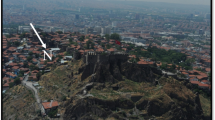Abstract
The Afyon Castle is a tourist destination and a historical site in the City of Afyon in Turkey. The Castle is located on a steep hill, with a height of 226 m. In close proximity to the Castle there are settlements. The hill consists of trachitic andesite. The rock contains columnar joints and flow layering. Owing to these discontinuities, blocks of varying sizes had fallen down. The settlement areas near the Castle are now in danger because of the rockfall risk. In this study, rockfall analysis was carried out along nine profiles of the hill. Fall-out distance, bounce height, kinetic energy and velocity of the rocks along each profile were investigated. The results of the analyses were evaluated, and the areas delineated as susceptible to rockfall risk are highlighted. Remedial measures including rock bolts and protective fences were suggested on the basis of the field observations and the rockfall risk evaluation.













Similar content being viewed by others
References
Agliardi F, Crosta GB (2003) High resolution three-dimensional numerical modelling of rockfalls. Int J Rock Mech Min Sci 40:455–471
Anon (1979) Classification of rocks and soils for engineering geological mapping. Part 1 Rock and soil materials. Bull Int Assoc Eng Geol 19:364–371
Azzoni A, Barbera LG, Zaninetti A (1995) Analysis and prediction of rockfalls using a mathematical model. Int J Rock Mech Min Sci Geotech Abstr 32:709–724
Basarir E, Kun N (1982) Afyon kalesi çevresindeki volkanik kayaçların petroğrafik incelemesi. KTÜ Yerbilimleri 4:95–124
Budetta P, Santo A (1994) Morphostructural evolution and related kinematics of rockfalls in Campania (southern Italy). Eng Geol 36:197–210
Chau KT, Wong RHC, Lee CF (1998) Rockfall problems in Hong Kong and some new experimental results for coefficients of restitution. Int J Rock Mech Min Sci 35:662–663
Chau KT, Wong RHC, Wu JJ (2002) Coefficient of restitution and rotational motions of rockfall impacts. Int J Rock Mech Min Sci 39:69–77
Chau KT, Wong RHC, Liu J, Lee CF (2003) Rockfall hazard analysis for Hong Kong based on rockfall inventory. Rock Mech Rock Eng 36:383–408
Chen H, Chen RH, Huang TH (1994) An application of an analytical model to a slope subject to rockfalls. Bull Assoc Eng Geol 31:447–458
Dorren LKA (2003) A review of rockfall mechanics and modelling approaches. Progr Phys Geogr 27:69–87
Dorren LKA, Maier B, Putters US, Seijmonsbergen AC (2004) Combining field and modelling techniques to assess rockfall dynamics on a protection forest hillslope in the European Alps. Geomorphology 57:151–167
Evans SG, Hungr O (1993) The assessment of rockfall hazard at the base of talus slopes. Can Geotech J 30:620–636
Giani GP (1992) Rock slope stability analysis. A. A. Balkema, Rotterdam
ISRM (1981) Rock characterization, testing and monitoring. In: Brown ET (ed) Suggested methods. International Society for Rock Mechanics, Pergamon Press, Oxford
ISRM (1985) Suggested method for point load strength. Int J Rock Mech Mineral Sci Geotech Abstr 22:51–60
Jaboyedoff M, Dudt JP, Labiouse V (2005) An attempt to refine rockfall hazard zoning based on the kinetic energy, frequency, and fragmentation degree. Nat Hazards Earth Syst Sci 5:621–632
Kocyigit A, Ozacar A (2003) Extensional neotectonic regime through the NE edge of the Outer Isparta Angle, SW Turkey: new field and seismic data. Turk J Earth Sci 12:67–90
Marzorati S, Luzi L, Amicis MD (2002) Rock falls induced by earthquakes: a statistical approach. Soil Dyn Earthquake Eng 22:565–577
Metin S, Genç S, Bulut V (1987) Afyon ve dolayinin jeolojisi. MTA Jeoloji Etütleri Dairesi, Ankara, Derleme No:8103
MTA (1963) Geological map of Turkey. 1/500 000 scaled Ankara sheet
Nicot F, Cambou B, Mazzoleni G (2001) Design of rockfall restraining nets from a discrete element modelling. Rock Mech Rock Eng 34:99–118
Okura Y, Kitahara H, Sammori T, Kawanami A (2000) The effects of rockfall volume on runout distance. Eng Geol 58:109–124
Paronuzzi P (1989) Probabilistic approach for design optimization of rockfall protective barriers. Q J Eng Geol 22:175–183
Peila D, Pelizza S, Sasudelli F (1998) Evaluation of behaviour of rockfall restraining nets by full scale tests. Rock Mech Rock Eng 31:1–24
Priest SD (1993) Discontinuity analysis for rock engineering. Chapman & Hall, London
Ritchie AM (1963) Evaluation of rockfall and its control. Highway Res Board Rec 17:13–27
Rocscience (2002) RocFall software—for risk analysis of falling rocks on steep slopes. Rocscience User’s Guide 59 p
Schweigl J, Ferretti C, Nossing L (2003) Geotechnical characterization and rockfall simulation of a slope: a practical case study from south Tyrol (Italy). Eng Geol 67:281–296
Spang RM, Rautenstrauch RW (1988) Empirical and mathematical approaches to rockfall protection and their practical applications. In: Proceeding of the 5th international symposium on landslides. Rotterdam, Balkema, pp 1237–1243
TS 699 (1987) Methods of testing for natural building stones. Turkish Standards Institute (in Turkish)
Ulusay R, Kasapoglu KE, Dirik K, Gökceoglu C (2002) 3 Şubat 2002 Sultandağı (Afyon) Depremi Saha İnceleme Raporu, H.Ü. Jeoloji Mühendisliği Bölümü, 44 p
Wasowski J, Gaudio VD (2000) Evaluating seismically induced mass movement hazard in Caramanico Terme (Italy). Eng Geol 58:291–311
Acknowledgments
This study is financially supported by METU BAP Project (2004-03-09-02). The authors gratefully acknowledge Afyon Municipality, especially Yavuz Unver, Mehmet Guzelkaya, and Hursit Erdogan for their support during the field test, and providing documents related to the Afyon Castle. The authors would also like to express their thanks to the anonymous reviewer(s) of this journal for their constructive comments and suggestions on the manuscript.
Author information
Authors and Affiliations
Corresponding author
Rights and permissions
About this article
Cite this article
Topal, T., Akin, M. & Ozden, U.A. Assessment of rockfall hazard around Afyon Castle, Turkey. Environ Geol 53, 191–200 (2007). https://doi.org/10.1007/s00254-006-0633-2
Received:
Accepted:
Published:
Issue Date:
DOI: https://doi.org/10.1007/s00254-006-0633-2




